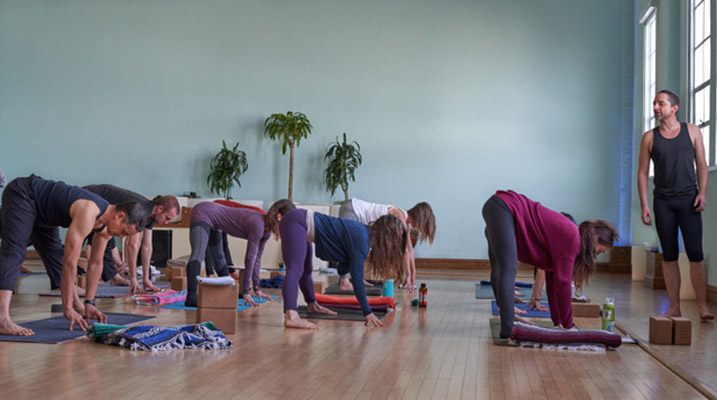In my formative training as a (modern postural) yoga teacher, I was taught to create classes using a full spectrum (or potpourri) sequence template. There are multiple variations of this template, but something like: centering-warm ups-standing poses-hip openers-abdominal strengtheners-arm balances-thigh stretches-backbends-twists-forward bends-inversions-meditation-restorative/savasana. While this template is useful and effective in many ways, after many years of experience, I find it mostly uninteresting and ambiguous to teach in this way.
 This template was useful in my early years of teaching because: (1) It provided me, as a newer teacher, with clear guidelines and parameters in each section of class and made the whole process less overwhelming. I didn’t need to have particular reasons to include parsvakonasana (side angle pose), I simply included it because it’s a common standing pose and it fits in that section of the template. (2) It gave me some room to be creative in each section to choose the poses, as well as in the overall direction of the sequence to a peak pose. (3) It ensured that each class I offered followed a familiar arc that provided the students with a consistent and predictive experience, thus fulfilling the students’ expectations of what a yoga class ’should be’. (4) And lastly, it promised that each class was a reasonably ‘well-rounded’ or ‘balanced’ experience.
This template was useful in my early years of teaching because: (1) It provided me, as a newer teacher, with clear guidelines and parameters in each section of class and made the whole process less overwhelming. I didn’t need to have particular reasons to include parsvakonasana (side angle pose), I simply included it because it’s a common standing pose and it fits in that section of the template. (2) It gave me some room to be creative in each section to choose the poses, as well as in the overall direction of the sequence to a peak pose. (3) It ensured that each class I offered followed a familiar arc that provided the students with a consistent and predictive experience, thus fulfilling the students’ expectations of what a yoga class ’should be’. (4) And lastly, it promised that each class was a reasonably ‘well-rounded’ or ‘balanced’ experience.
I’ve been teaching yoga full time for almost 20 years and I rarely sequence this way (at least when teaching alignment based classes and workshops, vinyasa sequencing is another topic). While it was useful for many years, the more I furthered my knowledge and craft of teaching, I came to find this template increasingly limiting for a few reasons: (1) I felt increasingly ambiguous about why many of the poses were in the sequence. Including poses just because they were usually included, and teaching them in a ‘normal’ way, were no longer compelling enough reasons for me. I had to question my own assumptions and all the rules and shoulds/shouldn’ts and always/nevers that I had been taught. If ignorance is indeed bliss, as the cliché says, then knowledge is auspicious agitation and discontent. (2) I had developed my knowledge and teaching craft to the point where I had many ways to teach every pose and work into it further. I knew more. I wanted to teach more. I wanted to unpack things further and get at deeper layers. But to interrogate poses to greater complexity meant more repetition of fewer poses, and subsequently we would cover less ground in that full spectrum arc. (3) I had developed my confidence as a teacher that I no longer felt the need to provide students with a familiar experience that fulfilled their expectations. I wanted them to learn more and grow further. To do this, we have to get out of the comfort zone of what is familiar and predictive; learning happens where knowledge meets ignorance, where comfort meets discomfort, where courage meets fear. (4) If any one class does not need to claim that it’s a ‘well rounded’ or ‘balanced’ practice, then each class can have more and more of it’s own flavor and identity. And that over time, say a month or 6 weeks of classes, students are getting a well rounded portfolio and movement and range of experience and education.
Receive rare news and yoga content from us.
"*" indicates required fields